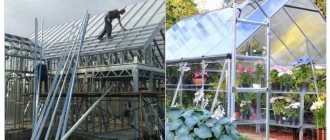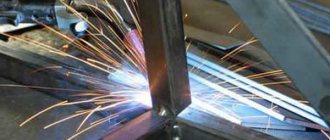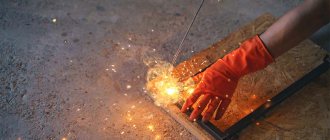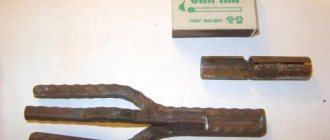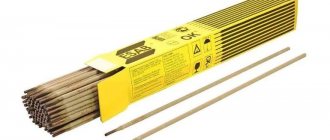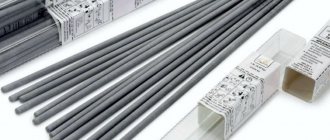Types of electrode coating according to GOST 9466-75 are divided into acidic
,
cellulosic
,
rutile
and
basic
.
There are also electrodes with a mixed type of coating, for example, rutile-cellulose
or
rutile acid
, and electrodes with other types of coatings that do not belong to the above and are designated by the letter “P”.
And if the coating contains iron powder in an amount of more than 20%, the letter “F” is added to the designation of the type of electrode coating. According to the European standard DIN EN 499, electrodes are also divided into four types: C – cellulose, A – acid, R – rutile, B – basic .
In our article we will look at electrodes with four main types of coating, features of their application, as well as the pros and cons of various types of coating. Read about how to choose electrodes for welding here.
Content
- Acid coated electrodes (A)
- Advantages of acid-coated electrodes
- Disadvantages of acid-coated electrodes
- Areas of use
- Cellulose coated electrodes (C)
- Advantages of cellulose-coated electrodes
- Disadvantages of cellulose-coated electrodes
- Areas of use
- Rutile coated electrodes (P)
- Advantages of rutile-coated electrodes
- Disadvantages of rutile-coated electrodes
- Areas of use
- Popular brands of rutile-coated electrodes
- Electrodes with basic coating (B)
- Advantages of electrodes with basic coating
- Disadvantages of electrodes with basic coating
- Areas of use
- Popular brands of electrodes with basic coating
Drying and calcination of electrodes
During transportation or storage, the electrodes may become damp. In this case, preliminary drying is needed, or even better, calcination. This is a very important procedure, which ultimately has a positive effect on arc ignition.
You should not frequently resort to calcining the electrodes, since repeated heating can damage the coating of the rod. It is advisable to undergo the procedure only the number of electrodes required for the current work. Or there should be very few of them left.
Piercing is also practical because it raises the temperature of the electrodes immediately before work. This is important, for example, for welding pipes or when working with thick workpieces. Preheating makes it possible to obtain tight joints during “pressure welding”. But keep in mind that gradual heating is important. With a sharp change in temperature, the formation of limescale cannot be ruled out.
Calcination is associated with the deadlines and duration of storage of the electrodes. According to generally accepted standards, the maximum shelf life of domestic products is five years. In practice, electrodes can be stored slightly longer without losing their characteristics.
Acid coated electrodes (symbol A)
The composition of acid-coated electrodes includes: oxides of iron, manganese and silicon. It is worth noting that toxic manganese oxides can be harmful to human health. Therefore, acid-coated electrodes are losing their popularity and are used less and less. Instead, mixed ones are used - rutile-acid.
According to the mechanical properties of the weld metal, electrodes with this type of coating belong to types E38 and E42 according to GOST 9467-75, having a tensile strength of up to 412 MPa . They are insensitive to scale and rust on the metal being welded, and also allow working with an extended arc. Welding with them can be performed on direct and alternating current.
When working with electrodes with this type of coating, due to the release of a large amount of oxygen during welding, the temperature of the arc increases and the surface tension of the molten metal decreases, which makes it very fluid. This allows you to increase the welding speed, but carries the risk of undercuts (one of the defects of the welded joint). In this case, the weld metal has an increased tendency to form hot cracks.
Advantages of acid-coated electrodes
- Easy ignition and stable arc burning
- Ability to carry out welding work on direct and alternating current
- When welding rusty or scaled metal, no pores form
- Resistance to moisture and mechanical stress
- Provides an even weld seam
- Good slag peel removal
Disadvantages of acid-coated electrodes
- Risk of undercuts
- Release of dangerous toxins
- Risk of hot cracking during welding
Areas of use
This type of electrode is used for welding non-critical low-alloy steel structures in construction and mechanical engineering.
Purpose of coverage
All types of electrodes are divided into non-metallic, which include graphite and carbon, and metal. In turn, electrodes made of metal are divided into non-consumable and consumable. Non-consumable electrodes do not require coating, but consumable elements need protection. This function is performed by a special coating of the metal inner rod, consisting of several components.
Coated electrodes contribute to the formation of a durable, high-quality seam without cracks or pores. During the welding process, it forms a shell of slag, which provides protection from negative external influences. It increases the cooling time of the joint, due to which all foreign inclusions that reduce its quality have time to leave the seam.
Welding with coated electrodes ensures stable arc combustion and ease of ignition. Due to the content of ferroalloys in the coating, oxygen is removed from the weld pool - the main culprit in the formation of pores at the joint.
The coating allows the formation of a cloud consisting of carbon dioxide and other gases. It provides protection against oxidation by atmospheric air. Saturation of the melt with alloying elements improves the quality of the connection. The consequence of the removal of oxygen from the melt is the process of deoxidation, which is ensured by substances such as aluminum, titanium, molybdenum, chromium, manganese, and graphite found in the coating. These components interact with oxygen more actively than oxygen, binding it.
To impart plasticity to the compound, bentonite and kaolin are added to the coating. For some types of electrodes, iron powder is added to the coating to increase the deposition rate. Manual arc welding with coated electrodes ensures a reliable and durable connection of metal products.
Electrodes with cellulose coating (symbol C)
Up to 50% of the composition of electrodes with a cellulose coating is made up of organic components, usually cellulose. It may also contain organic resins, ferroalloys, talc and other substances.
The weld metal obtained using cellulose electrodes corresponds in chemical composition to semi-quiet or calm steel. At the same time, it contains an increased amount of hydrogen. In terms of the mechanical properties of the weld metal, electrodes with this coating correspond to types E42, E46 and E50 according to GOST 9467-75 and have a tensile strength of up to 412 MPa, 451 MPa and 490 MPa , respectively.
Their main feature is the ability to make vertical seams from top to bottom. This is achieved due to the formation of a small amount of slag, which does not flow down, as well as a large amount of protective gases. During one-sided welding by weight, electrodes with a cellulose coating are characterized by the formation of a uniform back seam bead.
It should be noted that these electrodes have an increased amount of spatter and reduced ductility of the weld metal, due to the large amount of hydrogen generated during the combustion of organic components.
Advantages of cellulose-coated electrodes
- Easy ignition and stable arc burning
- Ability to perform welding work on both direct and alternating current
- Easy slag separation
- Possibility of welding in all spatial positions
- Excellent weld pool protection
- No release of dangerous toxins
- Clean root seam
Disadvantages of cellulose-coated electrodes
- Heavy splashes of metal
- Scaly surface suture
- High hydrogen content in shielding gas
- Tendency to small undercuts along edges (cracks)
- It is necessary to calcinate the electrodes before starting work.
Areas of use
Cellulose electrodes are used in welding low-alloy steels. Effective when welding the root seam of main pipelines.
Steel surfacing wire for electrodes
Steel surfacing wire is manufactured in accordance with the requirements of GOST 10543. The wire diameter ranges from 0.3 to 8.0 mm. Material: low-carbon, alloy or high-alloy steel.
There are surfacing wires made from carbon steel (grades Np-25, Np-40, etc.), from alloy steel (grades Np-40G, Np-50G, Np-30KhGSA, etc.) and from high-alloy steel (grades Np-20Kh14, Np-30Х13, Нп-30Х10Г10Т, etc.). The grade of wire is selected based on the required strength of the welded joint, depending on the purpose of the welded structure.
Depending on the type of surface, steel welding and surfacing wire can be copper-plated or non-copper-plated. Copper-plated wire is supplied upon customer's request. The surfacing wire from which electrodes for manual arc welding are made is symbolized by the letter E.
Electrodes with rutile coating (designation P)
The rutile type of electrode coating consists mainly of natural concentrate of rutile (titanium dioxide TiO2), silica (granite, feldspar, mica), calcium and magnesium carbonates, ferromanganese.
The weld metal, made with rutile-coated electrodes, corresponds to mild or semi-mild steel. Most brands of electrodes with rutile coating, according to the mechanical properties of the weld metal, belong to types E42 and E46 according to GOST 9467-75 and have a tensile strength of up to 412 MPa, 451 MPa , respectively. At the same time, rutile electrodes have a higher resistance of the weld metal to cracking than electrodes with an acid coating.
In addition to purely rutile coatings, mixed types are widespread: rutile-cellulose (RC), rutile-basic (RB), acid-rutile (AR) types , which also have good technological properties.
Electrodes with this type of coating are characterized by quiet melting with a small amount of spatter, and also ensure the transition of the metal rod into the weld pool in small or medium drops. They have easy arc re-ignition due to the presence of TiO2, often without contact of the electrode rod with the base metal. Due to this feature, it is quite convenient to work with short seams when frequent interruptions of the arc are necessary. The seam has a fine pattern, and the slag is easily separated from the weld metal. Another advantage of the rutile type of coating is its low sensitivity when working with wet and rusty metal and on an oxidized surface.
It should be noted that rutile coatings are less harmful to the health of the welder than others.
Advantages of rutile-coated electrodes
- Easy re-ignition
- Stable arc burning
- There is no need to prepare the surface for work
- High seam strength. Does not form hot and cold cracks in metal
- Provides a fine flake seam
- Easy slag separation
- Can be used with both AC and DC current
Disadvantages of rutile-coated electrodes
- It is necessary to calcinate the electrodes before starting work.
- It is necessary to control the current strength, because as it increases, the characteristics of the electrodes deteriorate
Areas of use
Rutile electrodes are very popular, as their scope of application is quite wide. For example, they are used in welding low-carbon structures and products, assembling piping structures, and welding and repairing worn parts.
Popular brands of electrodes with rutile coating
- GOODEL-OK46 – rutile-cellulose, type E46
- ANO-21 – rutile-cellulose, type E46
- OZS-4 – rutile, type E46
- OZS-12 – rutile, type E46
- MP-3 – rutile or rutile-cellulose, type E46
Cover sizes
When carrying out various welding operations, the correct choice of electrodes plays an important role. The greater the thickness of the product being welded, the larger the diameter of the electrode. Depending on this, the current value on the equipment is set.
Arc welding with coated electrodes requires a competent selection of these consumables. When choosing electrodes, the size of the coating on it should be analyzed. Each diameter value requires a specific coating thickness. The coating is applied to a certain length of the rod.
The gradation of this size, defined in GOST 9466-75, starts with thin ones and ends with especially thick ones. Between them are medium and thick. Coatings that have the status of thin are designated as “M”, medium ones as “C”. Thick ones are designated “D”, and especially thick ones are designated “G”. These letters are part of the general designation for coated electrodes.
For electrodes considered to be of the highest quality, the coating thickness is in the range from 0.5 to 2.5 millimeters. For electrodes with a small diameter, this size does not exceed 0.3 millimeters. The mass of the coating is approximately half of the total weight of the consumable element.
Coating, which is a solid porous substance, covers almost the entire rod, with the exception of a small area at its edge, approximately 20-30 millimeters in size. This area is left in order to place the electrode in a special holder to fix it, which makes it easier to work with.
Electrodes with basic coating (symbol B)
The electrodes with the main type of coating include magnesium and calcium carbonates (dolomite, marble, magnesite) and fluorspar (CaF2). The latter reduces work efficiency when using alternating current, so welding with such electrodes can only be performed with direct current. Mixed types containing less CaF2 allow work to be performed on alternating current.
The metal deposited with electrodes with a basic coating corresponds in chemical composition to mild steel. According to the mechanical properties of the weld metal, electrodes with a basic coating are of types E42A, E46A, E50A, E55 and E60 according to GOST 9467-75. The most common and popular type E50A has a tensile strength of up to 490 MPa . Index “A” indicates that the deposited metal has increased plastic properties .
Electrodes with this type of coating are characterized by high ductility and impact strength at normal and low temperatures, and also have increased resistance to the formation of hot cracks. This is achieved due to the low content of gases, non-metallic inclusions and harmful impurities. Also, the gas-protective environment of mineral origin, consisting mainly of CO and CO2, is devoid of hydrogen, which leads to the formation of cold cracks in the deposited metal. The transfer of metal into the weld pool occurs in medium and large drops, the molten metal becomes viscous.
However, in terms of technological characteristics, electrodes with a basic coating have their drawbacks. They are quite sensitive to the formation of pores in the presence of scale, rust and oil on the edges of the parts being welded, as well as when the coating is moistened and the arc is extended. They also require compliance with storage conditions (in a dry, ventilated area) and mandatory calcination at high temperatures before use. Welding is usually carried out with direct current of reverse polarity.
Advantages of electrodes with basic coating
- The seam has good toughness and ductility
- The metal contains small amounts of gases and impurities
- The joint is resistant to hot cracking
- Possibility of welding in all spatial positions
Disadvantages of electrodes with basic coating
- Sensitive to moisture - electrodes should be stored in a dry place
- When operating on alternating current, the arc may be unstable
- Lengthening the arc leads to the appearance of pores
- When working on wet surfaces, the connection may deteriorate
- Electrodes must be calcined before use.
- Before welding, it is necessary to prepare the surface
- Difficult for beginner welders
Areas of use
Electrodes with a basic coating are used when welding critical structures, when high demands are placed on the weld metal. Widely used for welding oil and gas pipelines, bridges and other critical structures.
Protective coatings for electrodes for manual arc welding
The protective coatings applied to the electrodes include various components that perform specific functions:
1. Gas-forming components. These include inorganic substances, such as marble CaCO3 and magnesite MgCO3, etc., and organic substances, such as starch, wood flour, etc.
2. Slag-forming components. These substances form the basis of the protective coating. Most often, the role of slag-forming agents is played by ores (manganese, titanium) or various minerals (ilmenite concentrate, rutile concentrate, feldspar, silica, granite, chalk, fluorspar, etc.).
3. Alloying elements and deoxidizing elements. These are silicon, manganese, titanium, nickel, chromium, etc. Aluminum is often used as a deoxidizing agent, which is introduced into the coating in the form of metal powder.
4. Binding components. The main component used to bind all components is liquid glass. Liquid glass is aqueous solutions of potassium and sodium silicates.
5. Molding elements. These are substances that give the coating plasticity. For this purpose, bentonite, kaolin, dextrin, mica and other components are used.
To ensure smooth burning of the electric arc, the coating composition includes alkali metal salts, liquid glass, etc. To increase productivity, the coating composition includes iron powder, the share of which can reach 60% of the total mass of the coating.
Requirements for electrodes
When choosing rods for work, you should carefully consider and evaluate them. The coating must be free of chips and damage, otherwise it will not be possible to achieve uniform heating and a uniform seam. At the tip of the electrode, the thickness of the lubricant should be the same as on the entire rod - thanks to this, the electric arc will pass through the center.
It is worth checking the humidity of the coating; sometimes the increased humidity of the coating does not allow the rod to light easily. Hence, the requirements for storing electrodes in a dry place, preferably hermetically sealed. Craftsmen recommend putting bags of salt in the packaging to remove excess moisture. If it happens that the electrodes become damp, they can be dried in the kitchen oven at low temperature. This parameter is indicated on the product packaging. You can also leave it in a ventilated, dry room.
During welding work, to obtain a high-quality, durable, stable seam, the following points must be taken into account:
- The correct amperage for a particular product.
- Suitable diameter of the welding electrode for the product and type of work.
- Taking into account the size and thickness of the materials being welded.
Having selected the parameters, the welder creates a stable, well-burning arc, which will ensure the implementation of welding work at a high level.
Electrode marking
There are dozens of modifications of types and brands of electrodes, so for successful orientation in their varieties, universal marking was introduced. Of course, by the marking of the electrode you can always understand what kind of coating it has. The main parameters in this case are the thickness and type of coating. In addition, the marking mentions the permissible spatial position of the weld, as well as the type of current.
An example of deciphering the markings of a coated electrode
For example, consider electrode E46.
- 1 – indicates the thickness of the coating (D is thick);
- 2 - means the type of coating (P is rutile);
- 3 - indicates the permissible position of the seam (1 - suitable for all positions);
- 4 is the type of current (1 means alternating and direct current of any polarity).
